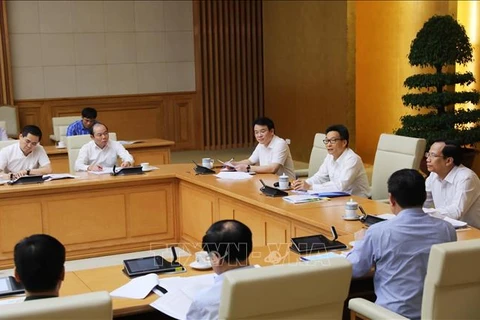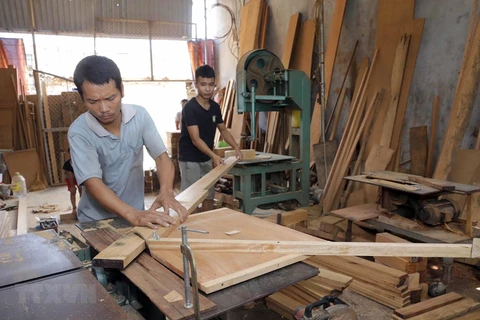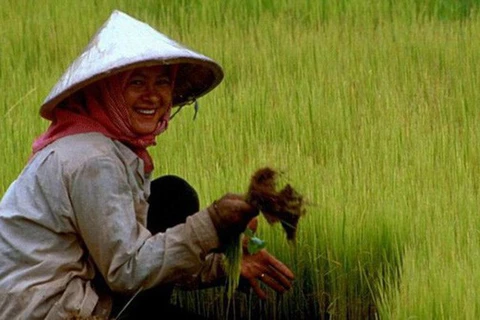 Women from poor households living in Muong Te District, Lai Chau Province, check loan programmes for production to escape poverty. (Photo: VNA)
Women from poor households living in Muong Te District, Lai Chau Province, check loan programmes for production to escape poverty. (Photo: VNA) Hanoi (VNS/VNA) - Government policies and programmes on poverty reduction have changed the lives of ethnic minority people in the northern border provinces.
Meo Vac district, one of the six poorest districts of the northernmost province of Ha Giang, as well as the country as a whole, is eligible for a special government support scheme, the programme 30A – a collection of comprehensive poverty alleviation efforts effective since 2008.
With support from 30A, the district with its mountainous terrain and rocky soil, has gradually escaped poverty.
The poverty rate reduced from 66.01 percent in 2015 to 35.99 percent in 2020, according to the local authority's report.
Dung A Duong, head of a near-poor household in Xin Cai commune, is among 20 households trying to climb out of poverty thanks to a project helping them to breed cows.
Duong said he is raising a herd of cows and is going to sell two of the animals. The money collected will help his family repay 40 percent of the support capital provided by the project.
Nguyen Cao Cuong, Chairman of Meo Vac district People's Committee, said poverty alleviation is an important task for the local government.
The local authorities have mobilised resources to create effective poverty reduction models in order to effectively implement the national target programme on poverty reduction, creating better livelihoods for the poor, he said.
In Lai Chau province, the local authorities and border guards have to build breeding and farming models to help ethnic minorities see production efficiency from changing farming methods, as part of efforts to help them rise above poverty.
At the beginning of 2018, border soldiers in Muong Te district in coordination with the local authorities developed a wet rice cultivation model with two crops a year in Ha Xi village.
They held a meeting to talk about the effectiveness of wet rice cultivation with the residents.
But after the meeting, only one household took part in the programme.
Hoang Hu Xa, the village pioneer, was supported by the border force to improve 1ha of land and bring water from the stream to the rice fields.
They also provided him seeds and fertilisers, as well as teaching him farming and harvesting methods.
In the first crop, Xa harvested two tonnes of paddy. The productivity doubled in the second crop.
Seeing the effects of the new farming model, many households asked the army to help them.
"I am a member of the Party and a village officer. So, I have to be a pioneer to take part in the trial programme on farming wet rice in order to help the residents see the effectiveness of this model," Xa told the Vietnam News Agency.
In order to achieve the goals of economic development and sustainable poverty reduction, some local governments have helped people settle on new land.
Nearly 270 Mong ethnic households of seven mountainous communes of Muong Khuong district, Lao Cai province, have been relocated to new settlement villages for economic development.
From the poverty reduction programme, the locality has allocated land and forests for people to cultivate and take care of, creating sustainable livelihoods.
Border security forces, the agriculture and rural development office in Muong Khuong district and local authorities called on people to turn wasteland filled with rocks into banana and pineapple farms.
Duong Hong Trung, Secretary of Ban Lau commune’s Party Committee, said: “Coc Phuong village has developed rapidly and become one of the villages with high income in Muong Khuong district. The income per capita reaches 40 million VND (1,720 USD) a year."
"Many households have earned hundreds of millions of dong a year. They build new houses and buy modern conveniences for their daily lives. People do not leave their fields and do not illegally cross borders to seek employment," said Trung.
Hundreds of billions of dong have been invested to provide roads, electricity, schools, irrigation and water supply, to help ethnic Mong people in border areas improve their lives and production, Trung said.
In 2015, 93 households in Ban Me commune, Si Ma Cai district, took part in a project called "Cow Bank" with 191 breeding cows to escape from poverty and attain a higher standard of living.
According to Vice Chairman of the Ban Me commune People's Committee Hang Seo Chang, the efficiency of raising cattle is higher than growing corn or rice. It is also less affected by the weather and farmers can earn stable incomes.
As a result, poverty reduction in the commune has been implemented quickly and sustainably.
The income per capita was 15.6 million VND per year in 2015 and reached 33 million VND in 2019, Chang said.
In recent years, border soldiers and officials in Lai Chau province have also implemented an economic development model: “Four Togethers – Eat Together, Live Together, Work Together and Speak the Local Ethnic Language Together.”
The model aims to improve local life, eradicate hunger and alleviate poverty through practical projects such as breeding cows.
Major Tran Ha Nam from the border post of Pa U commune, said the soldiers also help locals build houses, cultivate crops, and educate children.
Vice chairman of People's Committee of Lai Chau, Giang A Tinh affirmed that the investment policies for poverty reduction have reached the right beneficiaries.
The infrastructure system has been upgraded, making an important contribution to changing the face of mountainous areas, and basically solving people's needs for electricity, roads, schools, healthcare and promoting socio-economic development.
The locals have also brought varieties with high economic efficiency and applied science and technology in production, Tinh said.
In Nam Ban commune, an extremely poor commune of Nam Nhun district, the income per capita was only 3.5 million VND per year in 2015, with 80 percent of the population in poor households.
At present, the poverty rate has decreased to 65.67 percent, with income per capita reaching 14.5 million VND per year.
The implementation of poverty reduction programme in the 2016-20 period in border provinces such as Ha Giang, Lai Chau and Lao Cai has proved the effectiveness of the government support and investment policies to reduce poverty and reach the national target programme on sustainable poverty reduction.
However, the support policies are not synchronous and there are overlaps between ministries, agencies and localities.
According to Tran Duc Quy, Vice Chairman of the Ha Giang provincial People's Committee, the Government should study and accelerate the integration of policies to avoid overlaps and dispersion of resources.
Administrative procedures need to be simplified, helping localities to effectively implement the national target programme on sustainable poverty reduction.
Specifically, in Ha Giang, although the income of poor households in poor districts has improved significantly, the poor mainly lack basic services such as housing quality, water sources, hygienic latrines and information.
The vice chairman said in order to limit the disadvantages, it is necessary to allocate adequate budgets for ethnic minority people in disadvantaged and extremely disadvantaged groups.
Priority should be given to transport, raising cattle, electricity, irrigation and concentrated water supply works, Quy said./.
VNA























